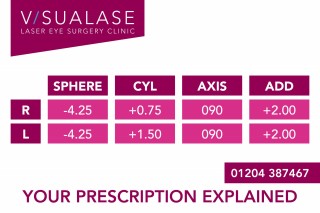
BOOK A CONSULTATION
or call our team: 01204 387467
Your Prescription Explained
Published on 14th October 2014 by Mr Manoj Mathai
Anyone who has ever worn glasses will have received a unique prescription that determines not only the precise measurements for each of your eyes and, as a result, the type and strength of glasses you may need, but is also used by specialist opthalmologists to determine whether you would be eligible for laser eye surgery.
But what exactly does that prescription mean?
Below is an example of a prescription. We then explain what each of the words and numbers mean.

Sph (Sphere)
The ‘sphere’ measurement determines whether you are short sighted (myopic) or long sighted (hyperopic). If you are myopic there will be a ‘-’ sign in this box. If you are long-sighted then a ‘+’ sign will be shown in the box.
The number recorded at the side of the + or - sign shows the strength of prescription you will need. The higher the number the stronger the prescription required.
CYL (Cylinder)
This box relates to whether you have an ‘astigmatism’ and how severe it is. Astigmatism is a visual distortion caused due to the shape of your cornea. Corneas should be shaped like a football but can be more oval (rugby ball) in some instances. The higher the number the more oval your eyes are.
Axis
This figure indicates the direction of the astigmatism and is measured in degrees.
Prism & Base
If you have any notes in these boxes it means that your eyes do not work together as they should, so will need specific lenses that will provide correction so you don’t suffer from double vision or headaches.
You may also have the word ‘ADD’ then a figure on the second row. This relates to whether there is a need for you to wear reading glasses and is known as Presbyopia.
This occurs when the natural lenses inside your eyes lose some of their flexibility so that it becomes difficult to focus on close-up objects. Presbyopia is a result of the eye’s ageing process and it affects everyone from their mid-40’s onwards.
Although laser treatment cannot correct presbyopia, allowances can be made for it by focusing one eye for distance vision and the other eye for near vision. This is known as monovision.
For a long time the only way to correct vision was by wearing glasses, or latterly, contact lenses, and of course many people continue to do so, so understanding your prescription is important.
However many people are now making the decision to free themselves of the hassle associated with wearing glasses or contact lenses by opting for laser eye surgery.
If you would like to discuss the options available to you, and have a consultation with one of our experienced eye surgeons, contact us to arrange an appointment.
To find out more about laser eye surgery click here.
All eye surgical procedures carry a level of risk including not obtaining the desired outcome, through to varying levels of visual loss. Your eye surgeon will discuss the risks and benefits, including ones specific to your circumstances, at the time of your pre-operative consultation.
